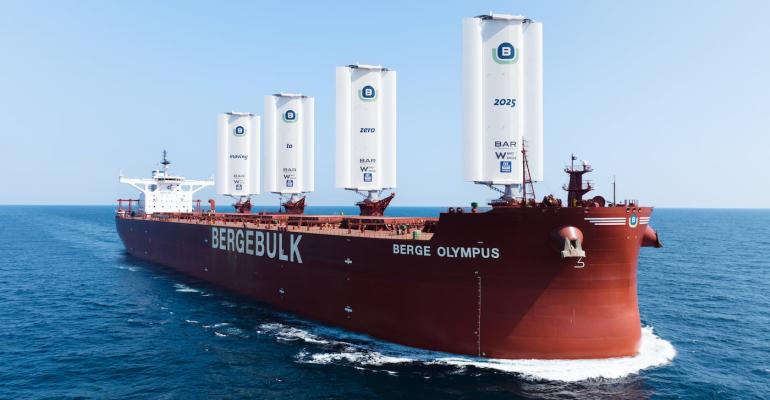The WindWings have been developed by Bar Technologies of the UK, a naval architecture and marine engineering consultancy, and Norway’s Yara Marine Technologies. Consisting of three components, the 37.5m-high wings align with the power of the wind to create the optimal forward thrust. The WindWings have a total surface area of 3,000 square metres, more than three times that of the wings of an Airbus A380.
Speaking to Seatrade Maritime News recently, Berge Bulk CEO James Marshall explained that the initiative is a key element in the company’s drive to become carbon-neutral by 2025, way ahead of most other shipping companies. It has already cut carbon emissions by 46% since 2008, he said.
Other initiatives on the 210,000dwt Berge Olympus include the installation of a shaft generator driven by the main engine so that auxiliary engines are not required at sea. The ship’s hull has also been coated with a high-grade silicon-based product.
The Berge Olympus project is part of the company’s four-pillar ‘Marshall Plan’ on decarbonisation. This comprises raising fleet efficiency; leveraging the latest maritime technology; piloting new fuels; and investing in carbon capture. The WindWings installation is likely to be the first of a series of similar initiatives across Berge Bulk’s 80-plus fleet, around 60 of which are Capesize bulkers or bigger.
John Cooper, Bar Technologies CEO, revealed that the Berge Olympus installation followed a pilot two-sail project on another vessel. The technology, he explained, avoids the risk of aerodynamic stall in which the power of the wind is suddenly lost.
Both men agree that wind energy is likely to become an integral component of ships’ power systems in the future, particularly as carbon pricing kicks in and shipping’s new fuels are likely to be several times more expensive than those of today.
Copyright © 2024. All rights reserved. Seatrade, a trading name of Informa Markets (UK) Limited.
Add Seatrade Maritime News to your Google News feed.  |

